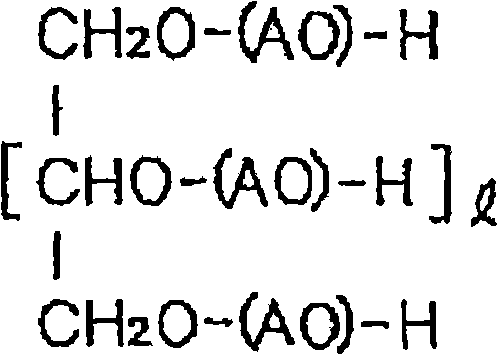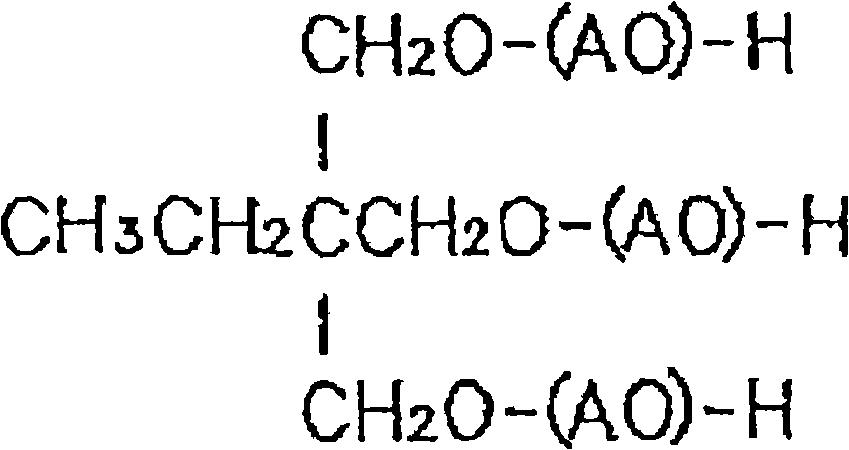Gel for ultrasonic phantom
An ultrasound and phantom technology, applied in applications, ultrasonic/sonic/infrasonic diagnosis, sonic diagnosis, etc., can solve the problems of ultrasonic characteristics fluctuations, bacterial reproduction has not been solved, etc., to achieve the effect of sufficient ultrasonic characteristics
- Summary
- Abstract
- Description
- Claims
- Application Information
AI Technical Summary
Problems solved by technology
Method used
Image
Examples
Embodiment 1
[0104] Polyols and polyisocyanates were prepared, each having a structure, molecular weight, and alkylene oxide (AO) segment corresponding to the structural formula numbers shown in Table 1 below, according to the corresponding parts shown in Table 1 section. Propylene carbonate as organogel swellable matrix and dibutyltin laurate as catalyst were mixed with polyols in the corresponding amounts in parts shown in Table 1. Thereafter, the obtained liquid mixture was mixed with polyisocyanate to prepare a material liquid having an OH / NCO of 2.7.
[0105] This material liquid was poured into a mold and reacted at 50° C. for 8 hours. In this way, a block polyurethane gel for ultrasonic phantom was obtained, which had EO / PO random copolymer segments with a EO / PO molar ratio of 1:1, and contained 50% by weight of propylene carbonate as Organogel swellable matrix.
[0106] For the obtained ultrasonic phantom, its density was checked with gel, and using a ring sound velocity meter [m...
Embodiment 2-5
[0112]The same procedure as in Example 1 was performed except that the parts of the amount of propylene carbonate as the organogel-swellable matrix were changed to 61.7 parts by weight, 99.6 parts by weight, 431.7 parts by weight and 1,048 parts by weight, respectively. Therefore, an ultrasound phantom gel containing 25% by weight of propylene carbonate (Example 2), an ultrasound phantom gel containing 35% by weight of propylene carbonate (Example 3), and an ultrasound phantom gel containing 70% by weight of An ultrasound phantom gel of propylene carbonate (Example 4), and an ultrasound phantom gel containing 85% by weight of propylene carbonate (Example 5).
[0113] In the same manner as in Example 1, the density, ultrasonic attenuation coefficient and ultrasonic propagation velocity of the gel for ultrasonic phantom were detected immediately after preparation, and the ultrasonic attenuation coefficient and ultrasonic propagation velocity were further detected after 8 months. ...
Embodiment 6
[0123] Polyols and polyisocyanates each having a structure, molecular weight, and alkylene oxide (AO) segment corresponding to the structural formula numbers shown in Table 3 below were prepared according to the amounts shown in Table 3 in parts. Propylene carbonate as an organogel swellable matrix and dibutyltin laurate as a catalyst were mixed with the polyol in the respective part numbers shown in Table 3. Thereafter, the obtained liquid mixture was mixed with polyisocyanate to prepare a material liquid having an OH / NCO of 4.0.
[0124] The liquid material was poured into a mold, and reacted at 50° C. for 8 hours. In this way, a block polyurethane gel for ultrasonic phantom was obtained, which had EO / PO random copolymer segments with an EO / PO molar ratio of 1:1, and contained propylene carbonate in an amount of 44% by weight As an organogel swellable matrix.
[0125] With this gel for ultrasound phantom, in the same manner as in Example 1, the density, ultrasound attenuat...
PUM
 Login to View More
Login to View More Abstract
Description
Claims
Application Information
 Login to View More
Login to View More - R&D Engineer
- R&D Manager
- IP Professional
- Industry Leading Data Capabilities
- Powerful AI technology
- Patent DNA Extraction
Browse by: Latest US Patents, China's latest patents, Technical Efficacy Thesaurus, Application Domain, Technology Topic, Popular Technical Reports.
© 2024 PatSnap. All rights reserved.Legal|Privacy policy|Modern Slavery Act Transparency Statement|Sitemap|About US| Contact US: help@patsnap.com










